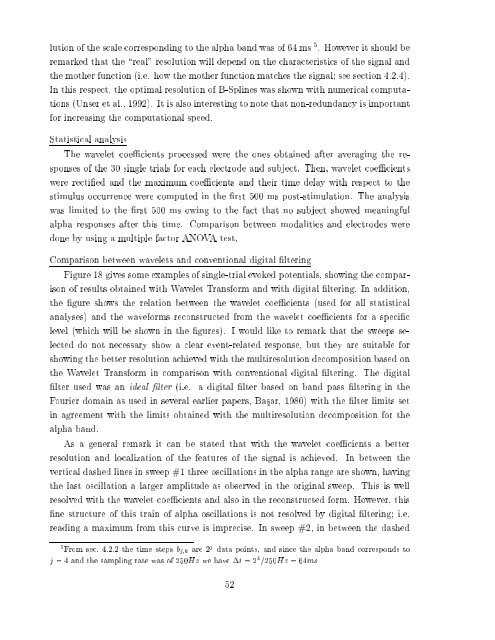Quantitative analysis of EEG signals: Time-frequency methods and ...
Quantitative analysis of EEG signals: Time-frequency methods and ...
Quantitative analysis of EEG signals: Time-frequency methods and ...
Create successful ePaper yourself
Turn your PDF publications into a flip-book with our unique Google optimized e-Paper software.
lution <strong>of</strong> the scale corresponding to the alpha b<strong>and</strong> was <strong>of</strong> 64 ms 5 . However it should be<br />
remarked that the \real" resolution will depend on the characteristics <strong>of</strong> the signal <strong>and</strong><br />
the mother function (i.e. how the mother function matches the signal see section 4.2.4).<br />
In this respect, the optimal resolution <strong>of</strong> B-Splines was shown with numerical computations<br />
(Unser et al., 1992). It is also interesting to note that non-redundancy is important<br />
for increasing the computational speed.<br />
Statistical <strong>analysis</strong><br />
The wavelet coecients processed were the ones obtained after averaging the responses<br />
<strong>of</strong> the 30 single trials for each electrode <strong>and</strong> subject. Then, wavelet coecients<br />
were rectied <strong>and</strong> the maximum coecients <strong>and</strong> their time delay with respect to the<br />
stimulus occurrence were computed in the rst 500 ms post-stimulation. The <strong>analysis</strong><br />
was limited to the rst 500 ms owing to the fact that no subject showed meaningful<br />
alpha responses after this time. Comparison between modalities <strong>and</strong> electrodes were<br />
done by using a multiple factor ANOVA test.<br />
Comparison between wavelets <strong>and</strong> conventional digital ltering<br />
Figure 18 gives some examples <strong>of</strong> single-trial evoked potentials, showing the comparison<br />
<strong>of</strong> results obtained with Wavelet Transform <strong>and</strong> with digital ltering. In addition,<br />
the gure shows the relation between the wavelet coecients (used for all statistical<br />
analyses) <strong>and</strong> the waveforms reconstructed from the wavelet coecients for a specic<br />
level (which will be shown in the gures). I would like to remark that the sweeps selected<br />
do not necessary show a clear event-related response, but they are suitable for<br />
showing the better resolution achieved with the multiresolution decomposition based on<br />
the Wavelet Transform in comparison with conventional digital ltering. The digital<br />
lter used was an ideal lter (i.e. a digital lter based on b<strong>and</strong> pass ltering in the<br />
Fourier domain as used in several earlier papers, Basar, 1980) with the lter limits set<br />
in agreement with the limits obtained with the multiresolution decomposition for the<br />
alpha b<strong>and</strong>.<br />
As a general remark it can be stated that with the wavelet coecients a better<br />
resolution <strong>and</strong> localization <strong>of</strong> the features <strong>of</strong> the signal is achieved. In between the<br />
vertical dashed lines in sweep #1 three oscillations in the alpha range are shown, having<br />
the last oscillation a larger amplitude as observed in the original sweep. This is well<br />
resolved with the wavelet coecients <strong>and</strong> also in the reconstructed form. However, this<br />
ne structure <strong>of</strong> this train <strong>of</strong> alpha oscillations is not resolved by digital ltering i.e.<br />
reading a maximum from this curve is imprecise. In sweep #2, in between the dashed<br />
5 From sec. 4.2.2 the time steps b jk are 2 j data points, <strong>and</strong> since the alpha b<strong>and</strong> corresponds to<br />
j = 4 <strong>and</strong> the sampling rate was <strong>of</strong> 250Hz we have t =2 4 =250Hz =64ms<br />
52




